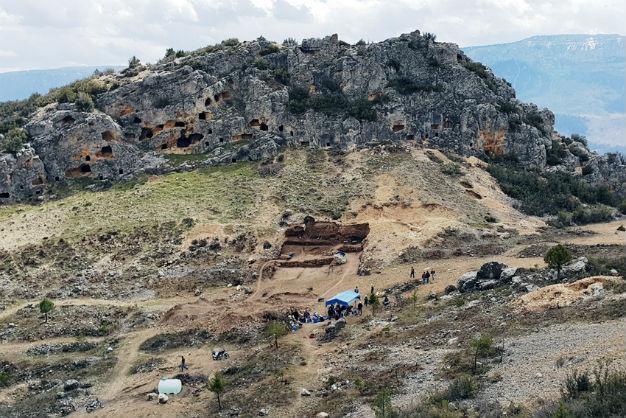Philadelphia, the ancient era health center
KARAMAN – Anadolu Agency

Surgical instruments and burial chambers unearthed during excavations in the ancient city of Philadelphia in the Central Anatolian province of Karaman’s Gökçeseki village have boosted the idea that the ancient city was the health center of the Taşeli region.
Karaman Museum Director Abdülbari Yıldız said the remains of the ancient city of Philadelphia lay on the 20th kilometer of the Ermenek-Mut highway north of the Çamlıca and Gökçeseki villages.
Yıldız said various architectural remains of the settlement survived on a hill, with a necropolis located on the northern part of the hill.
He said part of the mountainous Cilicia and Laconia regions, where Philadelphia was located, was gifted to Komagene King Antiochus 4th and his wife Lotape Philadelphos by Roman Emperor Caligula in 38 A.D.
“Antiochus established the Germanikopolis [Ermenek] and Philadelphia [Gökçeseki] cities and named them Germanicus, one of the titles of the emperor, and Philadelphia, his wife’s name. The name Philadelphia means ‘brotherly love’ at the same time,” he said.
Yıldız said Karamanoğlu Mehmetbey University started excavations at the ancient city’s necropolis in 2015, and explained:
“The excavations unearthed eight sarcophagi and a burial chamber in a field where illegal excavations were always carried out. In the west of the second sarcophagi group, an ancient field of waste was found. The artifacts found in this field were vows gifted to sarcophagi during ceremonies. The excavations have unearthed 2,100 movable cultural assets. Among them are 11 busts made of limestone, nearly 600 sharp objects such as catheters, medicine bottles and surgeon’s knives, coins, ceramic and glass pieces and ornaments.”
Burial chamber served as morgue
Yıldız said there were lots of human bones, skulls and metal objects like chain, rings and coins in the burial chamber, and continued:
“The skeletons were examined in the university’s anthropology laboratory. It was found that they were the remains of 53 people. Their age and gender were determined; infection was found in five people and head trauma in two of them. It shows that those who came here for treatment died and were buried in this mass grave. We also think that this grave served as a morgue, too.”
Yıldız said the medical tools were interesting, adding, “Nearly 600 medical tools were unearthed in the excavations. Among them were spatulas, catheters, medicine tubes and surgery instruments. Also, a crescent was seen in the necklaces of two female sculptures. The crescent depicts the God Men, a god living in the western and central parts of Anatolia in 4,000 B.C. He was the protector of poor and sick people. The moon was his symbol and he healed people with its power. These findings tell us that the ancient city was a health center.”
Yıldız noted the restoration and conservation of 107 of the findings were made in the Antalya Restoration and Conservation Regional Laboratory.
“The others were restored in the Karaman University lab. The excavations will continue this year. These artifacts are now on display at the museum and draw great attention. We are trying to find who the busts belonged to. If we can, maybe the busts of very important people in history will be seen for the first time,” he concluded.
 Surgical instruments and burial chambers unearthed during excavations in the ancient city of Philadelphia in the Central Anatolian province of Karaman’s Gökçeseki village have boosted the idea that the ancient city was the health center of the Taşeli region.
Surgical instruments and burial chambers unearthed during excavations in the ancient city of Philadelphia in the Central Anatolian province of Karaman’s Gökçeseki village have boosted the idea that the ancient city was the health center of the Taşeli region.